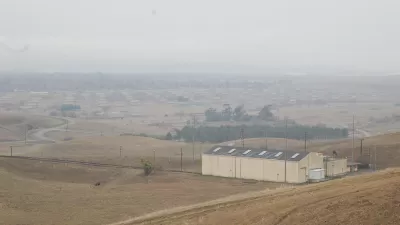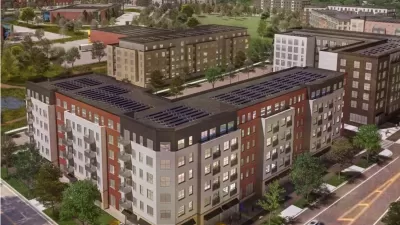The city of Concord, home to 130,000 but often neglected in the public consciousness of the San Francisco Bay Area, could set new standards for master planning practices.

John King provides a detailed update on one of the largest mega-development projects in Northern California right now—the $6 billion plan to convert a former naval weapons station to a master planned community including 13,000 homes, BART access, and a new approach to integrating a mix of uses into a new community.
"The potential canvas" for the project, writes King, "is the Concord Naval Weapons Station, a vast terrain dotted with trees and dozens of partially concealed ammunition bunkers."
"The emerging vision would place 13,000 housing units in structures ranging from multistory apartments above shaded colonnades to single-family homes on snug village greens. A transit corridor flanked by bicycle lanes would extend the length of the 3.4-mile-long site. Office buildings would cluster near the BART station at one end — parting to make room for a paseo-like footpath leading up to a ridgeline park."
While the project has been in works for the entire decade, a full plan and a draft environmental report are expected this winter, according to King, with a City Council vote on the project not likely for another year after that.
More than just providing details news coverage of the project, King also lends an assessment, as the San Francisco Chronicle's urban design critic, of the project's value to the city and the larger Bay Area. According to King, "in a region hobbled by the challenge of finding ways to add sizable amounts of housing in a manner that feels humane, the scenario in Concord offers heartening promise on a truly large scale."
In addition to the project's ability to deliver a large amount of housing in a supply constrained market, King also approves of how the planning and design details of the project are taking shape:
Plans at this stage often promise more than real life delivers. There’s no shortage of infill “placemaking” efforts in recent years that are hollow shells of their initial hype.
Nevertheless, it’s exciting to see a major firm focused on large-scale suburban futures — how to add density in a way that would take cues from its more settled surroundings while adding new layers to the scene.
FULL STORY: Concord weapons station has fraught history, but development concept has promise

Alabama: Trump Terminates Settlements for Black Communities Harmed By Raw Sewage
Trump deemed the landmark civil rights agreement “illegal DEI and environmental justice policy.”

Planetizen Federal Action Tracker
A weekly monitor of how Trump’s orders and actions are impacting planners and planning in America.

The 120 Year Old Tiny Home Villages That Sheltered San Francisco’s Earthquake Refugees
More than a century ago, San Francisco mobilized to house thousands of residents displaced by the 1906 earthquake. Could their strategy offer a model for the present?

In Both Crashes and Crime, Public Transportation is Far Safer than Driving
Contrary to popular assumptions, public transportation has far lower crash and crime rates than automobile travel. For safer communities, improve and encourage transit travel.

Report: Zoning Reforms Should Complement Nashville’s Ambitious Transit Plan
Without reform, restrictive zoning codes will limit the impact of the city’s planned transit expansion and could exclude some of the residents who depend on transit the most.

Judge Orders Release of Frozen IRA, IIJA Funding
The decision is a victory for environmental groups who charged that freezing funds for critical infrastructure and disaster response programs caused “real and irreparable harm” to communities.
Urban Design for Planners 1: Software Tools
This six-course series explores essential urban design concepts using open source software and equips planners with the tools they need to participate fully in the urban design process.
Planning for Universal Design
Learn the tools for implementing Universal Design in planning regulations.
Clanton & Associates, Inc.
Jessamine County Fiscal Court
Institute for Housing and Urban Development Studies (IHS)
City of Grandview
Harvard GSD Executive Education
Toledo-Lucas County Plan Commissions
Salt Lake City
NYU Wagner Graduate School of Public Service





























